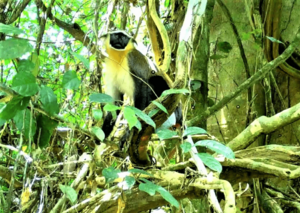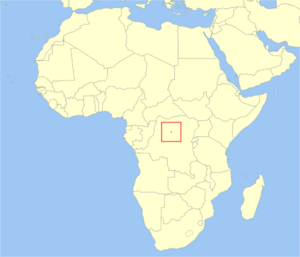Salonga monkey facts for kids
Quick facts for kids Dryas monkey |
|
|---|---|
 |
|
| Conservation status | |
| Scientific classification | |
| Genus: |
Chlorocebus
|
| Species: |
dryas
|
 |
|
| Geographic range of first-known population (a second population is to the southeast, near the edge of the square) | |
| Synonyms | |
|
|
The Dryas monkey (Chlorocebus dryas) is also known as the Salonga monkey. People in its home area call it ekele or inoko. This special monkey is a type of Old World monkey. It lives only in the Congo Basin, on the left side of the Congo River.
Scientists once thought some monkeys called Cercopithecus salongo were different. But now we know they are actually Dryas monkeys. Some older books might say the Dryas monkey is a type of Diana monkey. However, it lives very far away from any known Diana monkey groups.
For a long time, not much was known about the Dryas monkey. But now we know it is very rare. There might be fewer than 200 of them left! Because of this, its status was changed to critically endangered in 2008. This means it is in great danger of disappearing forever. It is also listed on Appendix II of CITES, which helps control trade of endangered animals. In 2019, its status was changed to endangered. This happened after more Dryas monkeys were found in Lomami National Park.
Contents
What Does the Dryas Monkey Look Like?
An adult male Dryas monkey has a black nose and mouth area. It has white whiskers and a short, white beard on its face. The top part of its body, including its head, is a grayish-brown color. Its belly, tail, lower legs, and bottom are white. The upper parts of its legs are dark gray or black-brown, like the rest of its body.
Female Dryas monkeys and young monkeys have less white on their bodies. Their shoulders and bottoms are not white. Also, the upper parts of their arms are lighter than the males'. These monkeys are about 40 to 55 centimeters (16 to 22 inches) long. Their tails add another 50 to 75 centimeters (20 to 30 inches) to their length. Adult monkeys weigh between 4 and 7 kilograms (9 to 15 pounds). Males and females have different sizes, which is called sexual dimorphism.
Where Do Dryas Monkeys Live?
Dryas monkeys like to live in areas where forests have grown back after being cut down. These are called secondary forests. They can also live in lowlands, near rivers, or in swampy areas of the Congo.
What Do Dryas Monkeys Eat?
The Dryas monkey mainly eats plants. This includes fruits, young leaves, and flowers. Since these foods are not always available, they also eat small invertebrates. These small creatures, like insects, help them get enough food.
How Do Dryas Monkeys Behave?
Dryas monkeys are very social animals. They live in groups with only their own kind. Sometimes, they even live in groups with other monkey species. They use their eyes and sounds to talk to each other. This is important for talking to other Dryas monkeys and other animals.
When they live only with other Dryas monkeys, their groups can have up to 30 members. These groups usually have many young monkeys and females. But they only have one adult male.
Reproduction and Life Cycle
When females have babies, they usually have only one at a time. The baby grows inside the mother for about five months. Young monkeys are ready to have their own babies after three years. In the wild, Dryas monkeys are expected to live for 10 to 15 years. We don't know how long they live in zoos because there are no Dryas monkeys in captivity.
These monkeys move around on all four limbs. This is called quadrupedal movement.
Communication
Communication is very important for Dryas monkeys. They have special ways of talking to each other.
- Staring: They stare to show they are upset or angry. Their eyes stay still, eyebrows go up, and their scalp pulls back. Their face skin stretches, and their ears move back. This shows their eyelids, which are a different color and stand out from their face.
- Staring with open mouth: This is another angry look, often done with head-bobbing.
- Head-bobbing: This is also a sign of anger and is thought to be more aggressive.
- Presenting: Females use this behavior during mating season. It shows males they are ready to mate.
Protecting Dryas Monkeys
The IUCN thinks there are only about 200 Dryas monkeys left. However, it's hard to know the exact number because they are rarely seen. This is why they are listed as critically endangered.
Scientists think there are a few reasons why these monkeys are disappearing:
- Poaching: People hunt them for meat.
- Habitat loss: Their homes are being destroyed by logging and other human activities.
- Lack of information: Not knowing much about them makes them more vulnerable to dangers.
The Kokolopori Bonobo Reserve in the Democratic Republic of the Congo was first thought to be key to their survival. It was the only place trying to protect them. But in 2014, a second group of Dryas monkeys was found. This group is about 400 kilometers (250 miles) away from the first. Part of this second group is protected by the Lomami National Park.


